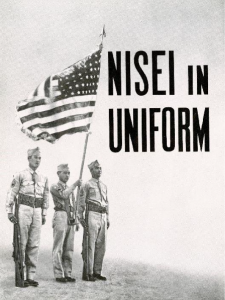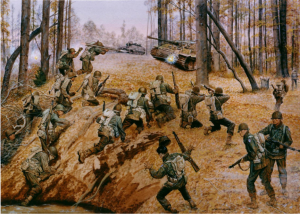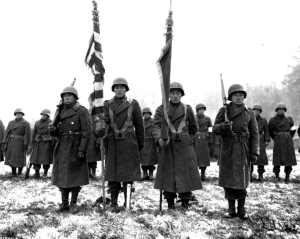The generation of Americans who survived the Great Depression and enlisted during World War II has often been called the “Greatest Generation.” Their stories of sacrifice, patriotism, and achievement are legion. Among them, the Japanese American soldiers of the 442nd Regimental Combat Team exemplified these qualities with extraordinary courage and devotion.
U.S. Army promotional pamphlet, 1943. Courtesy Wikimedia Commons.
Isolationism and Immigration
Between 1639 and 1852, Japan practiced a strict policy of isolationism, severely limiting contact between the island nation and the rest of the world and preventing most immigration to other countries. That policy began to change in 1853, when U.S. Commodore Matthew Perry sailed into Tokyo Harbor, bringing a glimpse of the outside world to Japan. Over the next few decades, Japan raced to adopt and adapt technologies and other advances used by the rest of the world and began allowing its citizens to immigrate to other countries. By 1911, more than 400,000 Japanese immigrants had made their way to the U.S. and its territories, with many moving to Hawaii before continuing on to other locations within the U.S.1
Japanese Americans in World War II
By 1940, more than 125,000 individuals of Japanese descent lived in the mainland U.S., of whom nearly 80,000 were born in the U.S. However, following the attack on Pearl Harbor on 7 December 1941, U.S. Secretary of War Henry Stimson and Lt. General John L. DeWitt recommended mass relocation and incarceration of America’s mainland Japanese population, fearing they might collaborate with the Japanese military against the U.S.2 In February 1942, President Franklin D. Roosevelt issued Executive Order 9066, authorizing the military to designate any part of the country as a “military area” and to determine who had the right to come and go in these areas.3 As a result, nearly 70,000 Japanese American citizens were forcibly removed and sent to internment camps. Additionally, in January 1942, men and women with Japanese ancestry were designated as 4-C, “enemy aliens,” and therefore were ineligible to enlist in the armed forces.4
However, by the end of the year, the U.S. military was struggling to attract enough men to fight the war on all fronts.5 Some in Roosevelt’s administration felt it was hurting the war effort to leave thousands of able-bodied young men trapped in internment camps, or working in Hawaii (where it was determined that interning them would be too harmful for the territory’s economy). Internees in the camps were required to complete a questionnaire, which asked if they would be willing to swear a loyalty oath and serve in the armed forces. The vast majority of those surveyed answered yes to both questions.6 On 9 February 1943, Roosevelt issued a memo announcing that all Nisei (American-born children of Japanese immigrants) were eligible to enlist.7
Formation of the 442nd Regimental Combat Team
On 23 March 1943, the 442nd Regimental Combat Team was organized, including 2,686 volunteers from Hawaii and 1,500 volunteers from the mainland.8 They were sent to Camp Shelby, Mississippi, for training, which they completed in April 1944. Some of the men were pulled out early and sent to Europe to bolster the ranks of the 100th Battalion, another regiment comprised mostly of Japanese Americans, already fighting in Europe.9
Battle of Belvedere
The 442nd arrived in Italy in June 1944. The 100th Battalion was incorporated into the 442nd as its first battalion, and the unit’s first combat experience was in Belvedere in Suvereto, Tuscany. As the 442nd progressed towards Belvedere, the Germans holding the higher ground attacked with mortar shells and tanks.10 The 442nd’s second and third battalions engaged the Germans, while the 100th Battalion flanked them. Although at times outnumbered and lacking artillery support, the soldiers continued fighting. A surprise attack by the 100th Battalion forced the Germans to retreat only to be ambushed by different companies of the 442nd. The regiment continued fighting the Germans throughout the end of June and early July, with little time to rest.11
Rescuing the Lost Battalion
The 442nd was later sent to Rome for training to participate in the invasion of southern France, known as Operation Dragoon.12 By this point, their reputation was well known, with the Germans referring to them as the “little iron men.” Reports of their accomplishments appeared in the Stars and Stripes newspaper. In September 1943, they were sent to Marseille and fought in the battles at Bruyères and Biffontaine in the Vosges Mountains.13 Following those engagements, they were tasked with rescuing the Lost Battalion—another group American soldiers who had been cut off and surrounded.
Painting depicting the 442nd Regimental Combat Team fighting in the Vosges Mountains in France.
Courtesy of Wikimedia Commons.
The Lost Battalion was trapped in treacherous terrain, and the would-be rescuers marched uphill into thick forests, with German tanks, machine gun nests, and rifle companies dug in at various points.14 The 442nd and 100th fought their way up, taking heavy losses. K and I companies started with hundreds of men, and within three days less than four dozen survived.15 After days of intense fighting, the 442nd reached and rescued the trapped soldiers. Despite being physically smaller than most other American soldiers, one of those rescued said the men of the 442nd “looked like giants to us.”16
The 442nd’s Heroics Continue
Following the rescue of the Lost Battalion, the 442nd spent several months in the Maritime Alps and French Riviera. Focusing mostly on patrols and guard duty, this time was known as the “Champagne Campaign” because of their relative safety and access to more comfortable quarters and food.17 But the easier times didn’t last, and the 442nd was sent back to Italy to help draw the Germans towards the west, allowing other Allied forces to take eastern Italy and end the war in that country.18 They were assigned a mission to scale the back side of a mountain in the dark, surprise the Germans, and capture the high ground between Folgorito and Monte Carchio before German observers could see them.19 Once again, they battled difficult terrain, snipers, machine gun nests, and artillery fire. And once again, the 442nd emerged victorious, capturing the high ground before 8:00 a.m. and forcing a break in the enemy lines.
Honoring the 442nd Infantry
The heroic actions of the 442nd earned them numerous awards: 21 Medals of Honor, 560 Silver Stars, 28 Silver Stars with oak leaf clusters, 22 Legion of Merit medals, 4,000 Bronze Stars, 1,200 Bronze Stars with oak leaf clusters, 36 Army Commendation medals, 87 Division Commendations, and more than 400 Purple Hearts. Additionally, Texas governor John Connally made the entire 442nd Regiment honorary Texans for their rescue of the Lost Battalion, which was made up mostly of soldiers from Texas.20 Ultimately, more than 18,000 men served in the 442nd. The regiment was the most decorated unit in U.S. military history, and their exploits continue to inspire today.
Members of the 442nd Regimental Combat Team receiving their citations in France in 1944.
Courtesy of Wikimedia Commons.
Ready to uncover your Japanese family history? Our expert genealogists can access records in the U.S. and onsite in Japan—many of which are not available online—to help you bridge the gap between past and present. Every day you wait is another day those stories remain untold. Connect with us today and take the first step toward discovering your Japanese roots.
Footnotes and Citations
1 “Immigration and Relocation in U.S. History,” Library of Congress (https://www.loc.gov/classroom-materials/immigration/japanese/: accessed 23 September 2025).
2 Daniel James Brown, Facing the Mountain (New York, New York: Viking, 2021), p. 76.
3 “Executive Order 9066: Resulting in Japanese-American Incarceration (1942),” National Archives (https://www.archives.gov/milestone-documents/executive-order-9066: accessed 23 September 2025).
4 Daniel James Brown, Facing the Mountain (New York, New York: Viking, 2021), p. 124.
5 Daniel James Brown, Facing the Mountain (New York, New York: Viking, 2021), p. 139.
6 Daniel James Brown, Facing the Mountain (New York, New York: Viking, 2021), p. 147.
7 Daniel James Brown, Facing the Mountain (New York, New York: Viking, 2021), p. 143.
8 “442nd Regimental Combat Team,” Densho Encyclopdia (https://encyclopedia.densho.org/442nd_Regimental_Combat_Team/: accessed 23 September 2025).
9 Daniel James Brown, Facing the Mountain (New York, New York: Viking, 2021), p. 218.
10 Daniel James Brown, Facing the Mountain (New York, New York: Viking, 2021), p. 255.
11 Daniel James Brown, Facing the Mountain (New York, New York: Viking, 2021), p. 270.
12 Daniel James Brown, Facing the Mountain (New York, New York: Viking, 2021), p. 318.
13 Daniel James Brown, Facing the Mountain (New York, New York: Viking, 2021), p. 331.
14 Daniel James Brown, Facing the Mountain (New York, New York: Viking, 2021), p. 362.
15 Daniel James Brown, Facing the Mountain (New York, New York: Viking, 2021), p. 367.
16 Daniel James Brown, Facing the Mountain (New York, New York: Viking, 2021), p. 371.
17 Daniel James Brown, Facing the Mountain (New York, New York: Viking, 2021), p. 400.
18 Daniel James Brown, Facing the Mountain (New York, New York: Viking, 2021), p. 409.
19 Daniel James Brown, Facing the Mountain (New York, New York: Viking, 2021), p. 412.
20 Daniel James Brown, Facing the Mountain (New York, New York: Viking, 2021), p. 466.




I gave a presentation to the 442nd reunion way back in my Hawaii days on Japanese genealogy! What a wonderful group! Thanks for the nice tribute and article!
Thank you so much for sharing that! What an incredible experience—and how special that you presented to the 442nd reunion. That must have been such a meaningful group to connect with. We’re so glad you enjoyed the tribute, and we truly appreciate the work you’ve done to preserve and share Japanese genealogy history!
Thanks for the nice tribute and article!